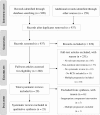Effects of nutrition interventions during pregnancy on low birth weight: an overview of systematic reviews
- PMID: 29018583
- PMCID: PMC5623264
- DOI: 10.1136/bmjgh-2017-000389
Effects of nutrition interventions during pregnancy on low birth weight: an overview of systematic reviews
Abstract
Introduction: Low birth weight (LBW, birth weight less than 2500 g) is associated with infant mortality and childhood morbidity. Poor maternal nutritional status is one of several contributing factors to LBW. We systematically reviewed the evidence for nutrition-specific (addressing the immediate determinants of nutrition) and nutrition-sensitive (addressing the underlying cause of undernutrition) interventions to reduce the risk of LBW and/or its components: preterm birth (PTB) and small-for-gestational age (SGA).
Methods: We conducted a comprehensive literature search in MEDLINE, EMBASE, CINAHL and the Cochrane Database of Systematic Reviews (September 2015). Systematic reviews of randomised controlled trials focusing on nutritional interventions before and during pregnancy to reduce LBW and its components were eligible for inclusion into the overview review. We assessed the methodological quality of the included reviews using A Measurement Tool to Assess Reviews (AMSTAR), PROSPERO: CRD42015024814.
Results: We included 23 systematic reviews which comprised 34 comparisons. Sixteen reviews were of high methodological quality, six of moderate and only one review of low quality. Six interventions were associated with a decreased risk of LBW: oral supplementation with (1) vitamin A, (2) low-dose calcium, (3) zinc, (4) multiple micronutrients (MMN), nutritional education and provision of preventive antimalarials. MMN and balanced protein/energy supplementation had a positive effect on SGA, while high protein supplementation increased the risk of SGA. High-dose calcium, zinc or long-chain n-3 fatty acid supplementation and nutritional education decreased the risk of PTB.
Conclusion: Improving women's nutritional status positively affected LBW, SGA and PTB. Based on current evidence, especially MMN supplementation and preventive antimalarial drugs during pregnancy may be considered for policy and practice. However, for most interventions evidence was derived from a small number of trials and/or participants. There is a need to further explore the evidence of nutrition-specific and nutrition-sensitive interventions in order to reach the WHO's goal of a 30% reduction in the global rate of LBW by 2025.
Keywords: child health; low birthweight; nutrition; pregnancy; preterm birth; small-for-gestational age.
Conflict of interest statement
Competing interests: JPP-R, EO, LMD-R and RM are authors and/or co-authors of included Cochrane reviews. They were not involved in the screening process or selection of reviews for inclusion. All other authors declare that they have no conflicts of interests.
Figures
References
-
- United Nations Children’s Fund. Undernourishment in the womb can lead to diminished potential and predispose infants to early death 2014. http://www.data.unicef.org/nutrition/low-birthweight.html (accessed 29 Jun 2017).
-
- WHO. International statistical classification of diseases and related health problems (ICD-10. 10 ed Geneva: World Health Organization, 2010.
Grants and funding
LinkOut - more resources
Full Text Sources
Other Literature Sources

